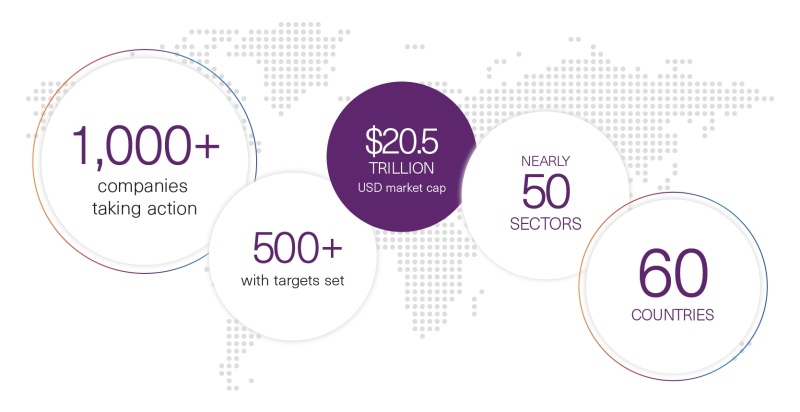
From ambition to impact
How companies are cutting emissions at scale with science-based targets
SBTi Progress Report 2020
Five years of progress: A decade of ambition ahead
We are embarking on a critical decade for climate action.
There are just 10 years left to halve global emissions and the spotlight is on governments to increase their climate commitments in advance of COP26 in Glasgow. Businesses have a critical role to play in driving government ambition and reducing emissions to avoid irreversible and catastrophic climate change.
Five years since the launch of the Science Based Targets initiative (SBTi) and the 2015 Paris Agreement, there has been a surge in corporate climate ambition, with SBTi companies leading the way.

Momentum is growing more quickly than ever
Over 1,000 companies spanning 60 countries and nearly 50 sectors – including one-fifth of the Global Fortune 500 – are working with the SBTi to reduce their emissions at the pace and scale necessary to prevent the worst effects of climate change.
These companies represent nearly 20% of global market capitalization (over $20.5 trillion USD). In spite of COVID-19, 370 organizations joined the SBTi between November 2019 and October 2020, at an average rate of 31 companies a month – more than double the average rate from 2015 to 2019.
From ambition to cutting emissions at scale
Companies with science-based targets have delivered emissions reductions at scale.
The 338 companies we analyzed have collectively reduced their annual emissions by 25% between 2015 and 2019 – a difference of 302 million tonnes of C02e, the same as the annual emissions from 78 coal-fired power plants.
1.5°C is the new north star
More companies than ever are setting targets aligned with limiting global warming to 1.5°C above pre-industrial levels.
As of October 2020, 41% of companies with approved science-based targets were 1.5°C-aligned, with many setting even bolder goals. Hundreds of companies are committing to net-zero emissions by 2050 and to setting science-based targets across their whole value chain through our Business Ambition for 1.5°C campaign.
Approaching a critical mass
Companies with science-based targets are beginning to represent a global movement.
In 16 OECD countries, at least 20% of high-emitting companies are setting science-based targets. According to the 'diffusions of innovations' theory, this threshold – a critical mass – could trigger a domino effect (a rapid adoption of science-based targets) in those markets.
In 2020, the 20% threshold was reached in six new sectors, including the high-emitting and hard to abate cement and concrete sector.
A system-wide change
Science-based targets are catalyzing system-wide change, including large-scale investment in mitigation activities and a greening of global supply chains.
The planned emissions reductions of companies with approved science-based targets will channel up to US$25.9 billion of new investment into mitigation activities over the next decade. Setting value chain targets (scope 3 targets) is now standard practice; 94% of companies with science-based targets include scope 3 emissions.
With the rapid growth of companies joining the SBTi, the potential future impact of science-based targets is huge:
2021: A year of opportunity for business leaders to seize
Five years on from the signing of the Paris Agreement and amidst the urgent challenges of COVID-19, 2021 will be a key year for accelerating climate action.
Companies setting science-based targets are making real and measurable differences to fighting climate change, but there is still much to be done.
By working towards ambitious targets and annually disclosing their progress, businesses from all sectors and regions can play their vital role, and give a clear signal to governments that they are ready for ambitious, bold policy.
Together we can unlock the system-wide change needed to build a sustainable and resilient future that works for people and planet.
Join the world’s biggest companies by cutting your GHG emissions
Testimonials
In 2017, we became the first company globally to set new, science-based targets in line with the 1.5 degree trajectory recommended in the Paris Climate Accord. Jason Tarry Tesco UK and ROI CEO
Latest News
View News

